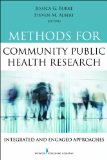Methods for Community Public Health Research Integrated and Engaged Approaches

Author: Jessica Burke, PhD, MHS, Steven Albert, PhD, MSPH
Affiliation: University of Pittsburgh Graduate School of Public Health
Publisher: Springer Publishing Company
Publication Date: 2014
ISBN 10: 0826198775
ISBN 13: 9780826198778
eISBN: 9780826198785
Edition: 1st
Affiliation: University of Pittsburgh Graduate School of Public Health
Publisher: Springer Publishing Company
Publication Date: 2014
ISBN 10: 0826198775
ISBN 13: 9780826198778
eISBN: 9780826198785
Edition: 1st
Description:
The Burke & Albert text is a "must-have" for all community researchers in public health. It contains innovative, community- engaged research methods that are described in an easily understandable manner. Challenging the notion of the quantitative- qualitative dichotomy, the contributors include integrated research methods including spatial analysis, concept mapping, network approaches, system dynamics, visual voice, and news media analysis. This is the first text to advance beyond traditional research methods for promoting community health by presenting a new paradigm that integrates qualitative and quantitative research methods. Written for graduate students of public health and practicing researchers, the book highlights new technologies and methodologies that are particularly suited to addressing complex health issues, translating research into action, and engaging the community and relevant stakeholders. Eschewing the rigid distinction between qualitative and quantitative methods, this new paradigm facilitates a more fluid use of integrated methods and interdisciplinary expertise. With a focus on inferring meaning, the book stresses the conjoint effects of place, time, voice, organization, and scale on health outcomes. Use of these new research methods will provide greater insight into how and why contextual and community factors impact health and aid in developing more effective intervention programs. The text focuses on new methods for inferring meaning from both the quantitative information that characterizes communities and the words community members use to describe their lives. It pays particular attention to data collection and analysis and clearly demonstrates the intricacies of using spatial, systems, and modeling analysis for community health. The first section on inferring meaning from numbers includes spatial analysis, agent- based models, community network analysis, and realist reviews.
Related Titles
